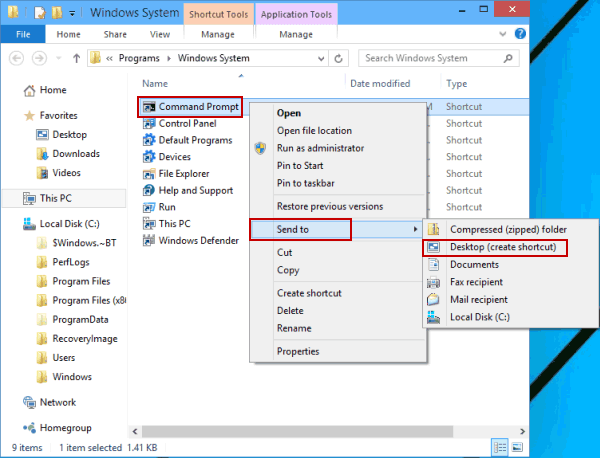

- #SHORTCUT FOR COMMAND PROMPT WINDOWS 10 HOW TO#
- #SHORTCUT FOR COMMAND PROMPT WINDOWS 10 UPDATE#
- #SHORTCUT FOR COMMAND PROMPT WINDOWS 10 PLUS#
Type “cmd.exe” into the box and then click “Next.” From the context menu, select New > Shortcut. Right-click an empty spot on the Desktop. To open a Command Prompt window to any folder, Shift+right-click the folder in File Explorer and then choose “Open command window here.”Ĭreate a Shortcut for Command Prompt on the Desktop Open Command Prompt from a Folder’s Context Menu in File Explorer

Type “cmd” and then press Ctrl+Shift+Enter to open an administrator Command Prompt. Type “cmd” and then click “OK” to open a regular Command Prompt. Double-click the “cmd.exe” file or right-click the file and choose “Run as administrator.” You can also create a shortcut to this file and store the shortcut anywhere you like. Open File Explorer, and then navigate to the C:\Windows\System32 folder. Click “Command Prompt.” To open with administrative privileges, right-click Command Prompt and choose “Run as administrator.” Scroll down and expand the “Windows System” folder. Open Command Prompt By Scrolling Through the Start MenuĬlick Start.

To open Command Prompt with administrative privileges, right-click the result and then click “Run as Administrator.” You could also highlight the result with the arrow keys and then press Ctrl+Shift+Enter. Alternatively, click/tap on the microphone icon in Cortana’s search field and say “Launch Command Prompt.” You can easily open the Command Prompt by clicking Start and then typing “cmd” into the search box. Open Command Prompt from a Start Menu Search To quickly open a command prompt with administrative privileges from Task Manager, open the “File” menu and then hold the CTRL key while clicking “Run New Task.” This will immediately open Command Prompt with administrative privileges-no need to type anything. Open a Command Prompt in Admin Mode from Task Manager the Secret Easy Way You can also check the “Create this task with administrative privileges” to open Command Prompt as administrator. Open the “File” menu and then choose “Run New Task.” Type cmd or cmd.exe, and then click “OK” to open up a regular Command Prompt. RELATED: Seven Ways to Open the Windows Task Manager
#SHORTCUT FOR COMMAND PROMPT WINDOWS 10 HOW TO#
RELATED: How to Put the Command Prompt Back on the Windows+X Power Users Menu Open a Command Prompt from Task Manager
#SHORTCUT FOR COMMAND PROMPT WINDOWS 10 PLUS#
You can do pretty much everything in PowerShell that you can do in Command Prompt, plus a lot of other useful things. It’s very easy to switch back to showing the Command Prompt on the Power Users menu if you want, or you can give PowerShell a try.
#SHORTCUT FOR COMMAND PROMPT WINDOWS 10 UPDATE#
Note: If you see PowerShell instead of Command Prompt on the Power Users menu, that’s a switch that came about with the Creators Update for Windows 10. Press Windows+X to open the Power Users menu, and then click “Command Prompt” or “Command Prompt (Admin).” Open Command Prompt from Windows+X Power Users Menu Note: this article is based on Windows 10, but the majority of these methods should work in earlier versions of Windows, too. RELATED: 10 Useful Windows Commands You Should Know While it’s easy to just open the Command Prompt from the Start menu, that’s not the only way to do it. And in true keyboard-ninja spirit, the Command Prompt also supports all kinds of clever keyboard shortcuts that make it even more powerful. It allows you to do some things quicker than you can do them in the graphic interface and offers some tools that you just can’t find in the graphic interface at all. The Command Prompt is a pretty useful tool.


 0 kommentar(er)
0 kommentar(er)
